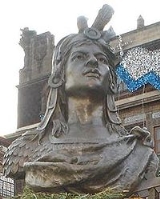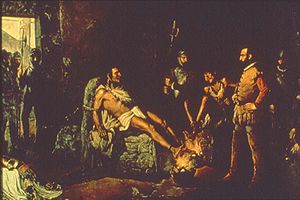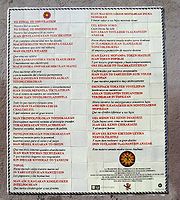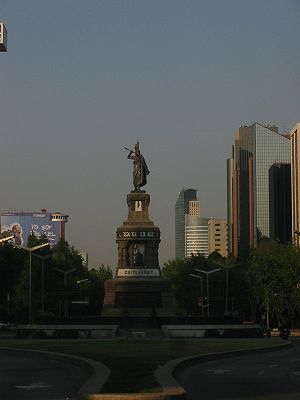
Cuauhtémoc
Encyclopedia
Cuauhtémoc was the Aztec
ruler (tlatoani
) of Tenochtitlan from 1520 to 1521. The name Cuāuhtemōc (Nahuatl pronunciation: [kʷaːʍˈtemoːk]) means "One That Has Descended Like an Eagle", commonly rendered in English as "Swooping Eagle" as in the moment when an eagle folds its wings and plummets down to strike its prey, so this is a name that implies aggressiveness and determination.
Cuauhtémoc took power in 1520 as successor of Cuitláhuac
and was a cousin of the former emperor Moctezuma II
, and his young wife, who would later be known as Isabel Moctezuma, was one of Moctezuma's daughters. He ascended to the throne when he was 25 years of age,as his city was being besieged by the Spanish
and devastated by an epidemic of smallpox
brought to the New World by Spanish Invaders. Probably after the killings in the main temple
, there were few Aztec captains available to take the position.
where even women took part in the battle. Cuauhtémoc was captured while fleeing Tenochtitlán by crossing Lake Texcoco
in disguise with his wife, family, and friends. He surrendered to Hernán Cortés
along with the surviving pipiltin
(nobles), and offered him his knife and asked to be killed.
At first, Cortés treated his foe chivalrously. "A Spaniard knows how to respect valor even in an enemy," he declared. However, he allowed Aldrete, the royal treasurer, to have Cuauhtemoc tortured to make him reveal the whereabouts of hidden treasure. Cuauhtémoc, insisting that there was no hidden treasure, stood up under the ordeal.
 Cuauhtémoc was tortured by having his feet put to a fire, along with Tetlepanquetzal
Cuauhtémoc was tortured by having his feet put to a fire, along with Tetlepanquetzal
, the tlatoani of Tlacopán
, and the Cihuacóatl (counselor) Tlacotzin
, but even so they refused to divulge information about the treasures the Spanish coveted. It is said that during the torture, Tetlepanquetzal asked him to reveal the location of the treasures in order to stop the pain given to them, and Cuauhtémoc is quoted to say "Do you think I am in a bath for pleasure?" This would be popularized in the 19th century as "Do you think I am in a bed of roses?" The date and details of this episode are unknown. In the end, a shamed Cortés delivered Cuauhtémoc from Aldrete's hands.
Eventually Cortés recovered some gold from a noble's house, but most of the tales about "Aztec gold" were a myth. Since for the Aztecs, gold had no intrinsic value, they did not have big solid pieces of gold, instead they preferred wood covered with gold. After those pieces were melted, they only gave a fraction of the gold that Cortés and his men expected.
 In 1525, Cortés took Cuauhtémoc and several other indigenous nobles on his expedition to Honduras
In 1525, Cortés took Cuauhtémoc and several other indigenous nobles on his expedition to Honduras
, fearing that Cuauhtémoc could have led an insurrection in his absence. While the expedition was stopped in the Chontal Maya capital of Itzamkanac, known as Acalan
in Nahuatl
, Cortés had Cuauhtémoc executed for allegedly conspiring to kill him and the other Spaniards.
 There are a number of discrepancies in the various accounts of the event. According to Cortés himself, on 27 February 1525 it was revealed to him by a citizen of Tenochtitlan named Mexicalcingo that Cuauhtémoc, Coanacoch
There are a number of discrepancies in the various accounts of the event. According to Cortés himself, on 27 February 1525 it was revealed to him by a citizen of Tenochtitlan named Mexicalcingo that Cuauhtémoc, Coanacoch
(the ruler of Texcoco) and Tetlepanquetzal
(the ruler of Tlacopan
) were plotting his death. Cortés interrogated them until each confessed, and then had Cuauhtémoc, Tetlepanquetzal, and another lord named Tlacatlec hanged. Cortés wrote that the other lords would be too frightened to plot against him again, as they believed he had uncovered the plan through magic powers. Cortés's account is supported by the historian Francisco López de Gómara
.
According to Bernal Díaz del Castillo
, a conquistador
serving under Cortés who recorded his experiences in his book The Conquest of New Spain
, the supposed plot was revealed by two men, named Tapia and Juan Velásquez. Díaz portrays the executions as unjust and based on no evidence, and admits to having liked Cuauhtémoc personally. He also records Cuauhtémoc giving the following speech to Cortés, through his interpreter
Malinche:
Díaz wrote that afterwards, Cortés suffered from insomnia
due to guilt
, and badly injured himself while wandering at night.
Fernando de Alva Cortés Ixtlilxóchitl
, a Mestizo
historian and descendant of Coanacoch, wrote an account of the executions in the 17th century partly based on Texcocan oral tradition
. According to Ixtlilxóchitl the three lords were joking cheerfully with each other, due to a rumor that Cortés had decided to return the expedition to Mexico, when Cortés asked a spy to tell him what they are talking about. The spy reported honestly, but Cortés invented the plot himself. Cuauhtémoc, Coanacoch and Tetlepanquetzal were all hanged, as well as eight others. However, Cortés cut down Coanacoch, the last to be hanged, after his brother began rallying his warriors. Coanacoch did not have long to enjoy his reprieve—Ixtlilxóchitl wrote that he died a few days later.
 Tlacotzin, Cuauhtémoc's cihuacoatl
Tlacotzin, Cuauhtémoc's cihuacoatl
, was appointed his successor as tlatoani. He died the next year before returning to Tenochtitlan.
The modern-day town of Ixcateopan in the state of Guerrero
is home to an ossuary
purportedly containing Cuauhtémoc's remains.
Many places in Mexico are named in honour of Cuauhtémoc. These include Ciudad Cuauhtémoc
in Chihuahua and the Cuauhtémoc
borough of the Mexican Federal District. There is also a Cuauhtémoc station
on the Mexico City metro
and the Monterrey Metrorrey. Cuauhtémoc is also one of the few non-Spanish given name
s for Mexican boys that is perennially popular. In the Aztec campaign of the PC game
Age of Empires II: The Conquerors
, the player plays as Cuauhtémoc, despite the name Montezuma
for the campaign itself, and Cuauhtémoc narrates the openings and closings to each scenario. In the next installment to the series, Age of Empires 3: The War Chiefs, Cuauhtémoc was the leader of Aztecs.
In the 1996 Rage Against The Machine
single People of the Sun
, lyricist Zack De La Rocha
rhymes "When the fifth sun sets get back reclaimed, The spirit of Cuauhtémoc alive an untamed".
Cuauhtémoc, in the name Guatemoc, is portrayed sympathetically in the adventure novel Montezuma's Daughter
, by H. Rider Haggard. First appearing in Chapter XIV, he becomes friends with the protagonist after they save each other's lives. His coronation, torture, and death are described in the novel.
Aztec
The Aztec people were certain ethnic groups of central Mexico, particularly those groups who spoke the Nahuatl language and who dominated large parts of Mesoamerica in the 14th, 15th and 16th centuries, a period referred to as the late post-classic period in Mesoamerican chronology.Aztec is the...
ruler (tlatoani
Tlatoani
Tlatoani is the Nahuatl term for the ruler of an altepetl, a pre-Hispanic state. The word literally means "speaker", but may be translated into English as "king". A is a female ruler, or queen regnant....
) of Tenochtitlan from 1520 to 1521. The name Cuāuhtemōc (Nahuatl pronunciation: [kʷaːʍˈtemoːk]) means "One That Has Descended Like an Eagle", commonly rendered in English as "Swooping Eagle" as in the moment when an eagle folds its wings and plummets down to strike its prey, so this is a name that implies aggressiveness and determination.
Cuauhtémoc took power in 1520 as successor of Cuitláhuac
Cuitláhuac
Cuitláhuac or Cuitláhuac was the 10th tlatoani of the Aztec city of Tenochtitlan for 80 days during the year Two Flint ....
and was a cousin of the former emperor Moctezuma II
Moctezuma II
Moctezuma , also known by a number of variant spellings including Montezuma, Moteuczoma, Motecuhzoma and referred to in full by early Nahuatl texts as Motecuhzoma Xocoyotzin, was the ninth tlatoani or ruler of Tenochtitlan, reigning from 1502 to 1520...
, and his young wife, who would later be known as Isabel Moctezuma, was one of Moctezuma's daughters. He ascended to the throne when he was 25 years of age,as his city was being besieged by the Spanish
Spain
Spain , officially the Kingdom of Spain languages]] under the European Charter for Regional or Minority Languages. In each of these, Spain's official name is as follows:;;;;;;), is a country and member state of the European Union located in southwestern Europe on the Iberian Peninsula...
and devastated by an epidemic of smallpox
Smallpox
Smallpox was an infectious disease unique to humans, caused by either of two virus variants, Variola major and Variola minor. The disease is also known by the Latin names Variola or Variola vera, which is a derivative of the Latin varius, meaning "spotted", or varus, meaning "pimple"...
brought to the New World by Spanish Invaders. Probably after the killings in the main temple
The massacre in the Main Temple, Tenochtitlán
The massacre in the Main Temple of the Aztec capital Tenochtitlan was an episode in the Spanish conquest of Mexico which occurred on May 10, 1520....
, there were few Aztec captains available to take the position.
Attempted escape and recapture
On August 13, 1521, Cuauhtémoc went to call for reinforcements from the countryside to aid the falling Tenochtitlán, after eighty days of continuous urban warfare against the Spanish. Of all the Nahuas, only Tlatelolcas remained loyal, and the surviving Tenochcas looked for refuge in TlatelolcoTlatelolco (altepetl)
Tlatelolco was a pre-Columbian Nahua altepetl in the Valley of Mexico. Its inhabitants were known as Tlatelolca. The Tlatelolca were a part of the Mexica ethnic group, a Nahuatl speaking people who arrived in what is now central Mexico in the 13th century...
where even women took part in the battle. Cuauhtémoc was captured while fleeing Tenochtitlán by crossing Lake Texcoco
Lake Texcoco
Lake Texcoco was a natural lake formation within the Valley of Mexico. The Aztecs built the city of Tenochtitlan on an island in the lake. The Spaniards built Mexico City over Tenochtitlan...
in disguise with his wife, family, and friends. He surrendered to Hernán Cortés
Hernán Cortés
Hernán Cortés de Monroy y Pizarro, 1st Marquis of the Valley of Oaxaca was a Spanish Conquistador who led an expedition that caused the fall of the Aztec Empire and brought large portions of mainland Mexico under the rule of the King of Castile in the early 16th century...
along with the surviving pipiltin
Pipiltin
The Pipiltin were the noble social class in the Mexica Empire.These people were members of the hereditary nobility and occupied the top positions in the government, the army and the priesthood...
(nobles), and offered him his knife and asked to be killed.
At first, Cortés treated his foe chivalrously. "A Spaniard knows how to respect valor even in an enemy," he declared. However, he allowed Aldrete, the royal treasurer, to have Cuauhtemoc tortured to make him reveal the whereabouts of hidden treasure. Cuauhtémoc, insisting that there was no hidden treasure, stood up under the ordeal.
Torture

Tetlepanquetzal
Tetlepanquetzal was a Mexican king, He was the fourth Tepanec king of Tlacopan, and reigned after 1503 as a tributary of the Mexican emperor Moctezuma II, whom he assisted in the first defence of Mexico...
, the tlatoani of Tlacopán
Tlacopan
Tlacopan , also called Tacuba, was a Pre-Columbian Mesoamerican city-state situated on the western shore of Lake Texcoco.Founded by Tlacomatzin, Tlacopan was a Tepanec kingdom subordinate to nearby Azcapotzalco...
, and the Cihuacóatl (counselor) Tlacotzin
Diego Velázquez Tlacotzin
Juan Velázquez Tlacotzin was Cihuacoatl during the tenure of Moctezuma II, and Cuauhtémoc. He was grandchild of the Cihuacoatl Tlacaeleltzin....
, but even so they refused to divulge information about the treasures the Spanish coveted. It is said that during the torture, Tetlepanquetzal asked him to reveal the location of the treasures in order to stop the pain given to them, and Cuauhtémoc is quoted to say "Do you think I am in a bath for pleasure?" This would be popularized in the 19th century as "Do you think I am in a bed of roses?" The date and details of this episode are unknown. In the end, a shamed Cortés delivered Cuauhtémoc from Aldrete's hands.
Eventually Cortés recovered some gold from a noble's house, but most of the tales about "Aztec gold" were a myth. Since for the Aztecs, gold had no intrinsic value, they did not have big solid pieces of gold, instead they preferred wood covered with gold. After those pieces were melted, they only gave a fraction of the gold that Cortés and his men expected.
Execution

Honduras
Honduras is a republic in Central America. It was previously known as Spanish Honduras to differentiate it from British Honduras, which became the modern-day state of Belize...
, fearing that Cuauhtémoc could have led an insurrection in his absence. While the expedition was stopped in the Chontal Maya capital of Itzamkanac, known as Acalan
Acalan
Acalan was a Chontal Maya region in what is now southern Campeche, Mexico. Its capital was Itzamkanac. The people of Acalan were called Mactun in the Chontal Maya language....
in Nahuatl
Nahuatl
Nahuatl is thought to mean "a good, clear sound" This language name has several spellings, among them náhuatl , Naoatl, Nauatl, Nahuatl, Nawatl. In a back formation from the name of the language, the ethnic group of Nahuatl speakers are called Nahua...
, Cortés had Cuauhtémoc executed for allegedly conspiring to kill him and the other Spaniards.

Coanacoch
Coanacochtzin was the seventh tlatoani of Texcoco.One of Nezahualpilli's sons, he succeeded to throne after the death of his half-brother Cacama in 1520....
(the ruler of Texcoco) and Tetlepanquetzal
Tetlepanquetzal
Tetlepanquetzal was a Mexican king, He was the fourth Tepanec king of Tlacopan, and reigned after 1503 as a tributary of the Mexican emperor Moctezuma II, whom he assisted in the first defence of Mexico...
(the ruler of Tlacopan
Tlacopan
Tlacopan , also called Tacuba, was a Pre-Columbian Mesoamerican city-state situated on the western shore of Lake Texcoco.Founded by Tlacomatzin, Tlacopan was a Tepanec kingdom subordinate to nearby Azcapotzalco...
) were plotting his death. Cortés interrogated them until each confessed, and then had Cuauhtémoc, Tetlepanquetzal, and another lord named Tlacatlec hanged. Cortés wrote that the other lords would be too frightened to plot against him again, as they believed he had uncovered the plan through magic powers. Cortés's account is supported by the historian Francisco López de Gómara
Francisco López de Gómara
Francisco López de Gómara was a Spanish historian who worked in Seville, particularly noted for his works in which he described the early 16th century expedition undertaken by Hernán Cortés in the Spanish conquest of the New World...
.
According to Bernal Díaz del Castillo
Bernal Díaz del Castillo
Bernal Díaz del Castillo was a conquistador, who wrote an eyewitness account of the conquest of Mexico by the Spaniards for Hernán Cortés, himself serving as a rodelero under Cortés.-Early life:...
, a conquistador
Conquistador
Conquistadors were Spanish soldiers, explorers, and adventurers who brought much of the Americas under the control of Spain in the 15th to 16th centuries, following Europe's discovery of the New World by Christopher Columbus in 1492...
serving under Cortés who recorded his experiences in his book The Conquest of New Spain
The Conquest of New Spain
Historia verdadera de la conquista de la Nueva España is the first-person narrative of Bernal Díaz del Castillo , the 16th-century military adventurer, conquistador, and colonist settler, who served in three Mexican expeditions; that of Francisco Hernández de Córdoba to the Yucatán peninsula; the...
, the supposed plot was revealed by two men, named Tapia and Juan Velásquez. Díaz portrays the executions as unjust and based on no evidence, and admits to having liked Cuauhtémoc personally. He also records Cuauhtémoc giving the following speech to Cortés, through his interpreter
Interpreting
Language interpretation is the facilitating of oral or sign-language communication, either simultaneously or consecutively, between users of different languages...
Malinche:
Díaz wrote that afterwards, Cortés suffered from insomnia
Insomnia
Insomnia is most often defined by an individual's report of sleeping difficulties. While the term is sometimes used in sleep literature to describe a disorder demonstrated by polysomnographic evidence of disturbed sleep, insomnia is often defined as a positive response to either of two questions:...
due to guilt
Guilt
Guilt is the state of being responsible for the commission of an offense. It is also a cognitive or an emotional experience that occurs when a person realizes or believes—accurately or not—that he or she has violated a moral standard, and bears significant responsibility for that...
, and badly injured himself while wandering at night.
Fernando de Alva Cortés Ixtlilxóchitl
Fernando de Alva Cortés Ixtlilxochitl
Fernando de Alva Cortés Ixtlilxóchitl was a Novohispanic historian.-Life:A Castizo born between 1568 and 1580, Alva Cortés Ixtlilxóchitl was a direct descendant of Ixtlilxochitl I and Ixtlilxochitl II, who had been tlatoque of Texcoco...
, a Mestizo
Mestizo
Mestizo is a term traditionally used in Latin America, Philippines and Spain for people of mixed European and Native American heritage or descent...
historian and descendant of Coanacoch, wrote an account of the executions in the 17th century partly based on Texcocan oral tradition
Oral tradition
Oral tradition and oral lore is cultural material and traditions transmitted orally from one generation to another. The messages or testimony are verbally transmitted in speech or song and may take the form, for example, of folktales, sayings, ballads, songs, or chants...
. According to Ixtlilxóchitl the three lords were joking cheerfully with each other, due to a rumor that Cortés had decided to return the expedition to Mexico, when Cortés asked a spy to tell him what they are talking about. The spy reported honestly, but Cortés invented the plot himself. Cuauhtémoc, Coanacoch and Tetlepanquetzal were all hanged, as well as eight others. However, Cortés cut down Coanacoch, the last to be hanged, after his brother began rallying his warriors. Coanacoch did not have long to enjoy his reprieve—Ixtlilxóchitl wrote that he died a few days later.
Legacy

Cihuacoatl (position)
The cihuacoatl was a supreme leader or advisor within the Aztec system of government....
, was appointed his successor as tlatoani. He died the next year before returning to Tenochtitlan.
The modern-day town of Ixcateopan in the state of Guerrero
Guerrero
Guerrero officially Estado Libre y Soberano de Guerrero is one of the 31 states which, with the Federal District, comprise the 32 Federal Entities of Mexico. It is divided in 81 municipalities and its capital city is Chilpancingo....
is home to an ossuary
Ossuary
An ossuary is a chest, building, well, or site made to serve as the final resting place of human skeletal remains. They are frequently used where burial space is scarce. A body is first buried in a temporary grave, then after some years the skeletal remains are removed and placed in an ossuary...
purportedly containing Cuauhtémoc's remains.
Many places in Mexico are named in honour of Cuauhtémoc. These include Ciudad Cuauhtémoc
Cuauhtémoc, Chihuahua
Ciudad Cuauhtémoc is a city located in the west-central part of the Mexican state of Chihuahua. It serves as the seat of the municipality of Cuauhtémoc....
in Chihuahua and the Cuauhtémoc
Cuauhtémoc, D.F.
Cuauhtémoc, named after the former Aztec leader, is one of the 16 boroughs of the Federal district of Mexico City. It consists of the oldest parts of the city, extending over what was the entire city in the 1920s. This area is the historic and culture center of the city, although it is not the...
borough of the Mexican Federal District. There is also a Cuauhtémoc station
Metro Cuauhtémoc
Metro Cuauhtémoc is a metro station on the Mexico City Metro.It is located at the northern extreme of Avenida Cuauhtémoc, in the Cuauhtémoc borough, in the centre of Mexico City.The station logo depicts the head of an eagle...
on the Mexico City metro
Mexico City Metro
The Mexico City Metro , officially called Sistema de Transporte Colectivo, is a metro system that serves the metropolitan area of Mexico City...
and the Monterrey Metrorrey. Cuauhtémoc is also one of the few non-Spanish given name
Given name
A given name, in Western contexts often referred to as a first name, is a personal name that specifies and differentiates between members of a group of individuals, especially in a family, all of whose members usually share the same family name...
s for Mexican boys that is perennially popular. In the Aztec campaign of the PC game
Personal computer game
A PC game, also known as a computer game, is a video game played on a personal computer, rather than on a video game console or arcade machine...
Age of Empires II: The Conquerors
Age of Empires II: The Conquerors
Age of Empires II: The Conquerors Expansion is the expansion pack to the 1999 real-time strategy game Age of Empires II: The Age of Kings. The Conquerors is the fourth installment in the Age of Empires series by Microsoft Game Studios and Ensemble Studios...
, the player plays as Cuauhtémoc, despite the name Montezuma
Moctezuma II
Moctezuma , also known by a number of variant spellings including Montezuma, Moteuczoma, Motecuhzoma and referred to in full by early Nahuatl texts as Motecuhzoma Xocoyotzin, was the ninth tlatoani or ruler of Tenochtitlan, reigning from 1502 to 1520...
for the campaign itself, and Cuauhtémoc narrates the openings and closings to each scenario. In the next installment to the series, Age of Empires 3: The War Chiefs, Cuauhtémoc was the leader of Aztecs.
In the 1996 Rage Against The Machine
Rage Against the Machine
Rage Against the Machine is an American rock band from Los Angeles, California. Formed in 1991, the group's line-up consists of vocalist Zack de la Rocha, bassist and backing vocalist Tim Commerford, guitarist Tom Morello and drummer Brad Wilk...
single People of the Sun
People of the Sun
"People of the Sun" is the second single by the American band Rage Against the Machine for their 1996 album Evil Empire. The song is about the Zapatista revolution. Lead vocalist Zack de la Rocha wrote the song after a visit to the Chiapas in southern Mexico. "People of the Sun" also has a music...
, lyricist Zack De La Rocha
Zack de la Rocha
Zacarías Manuel "Zack" de la Rocha is an American rapper, musician, poet, and activist best known as the vocalist and lyricist of Rage Against the Machine.-Early life and childhood:...
rhymes "When the fifth sun sets get back reclaimed, The spirit of Cuauhtémoc alive an untamed".
Cuauhtémoc, in the name Guatemoc, is portrayed sympathetically in the adventure novel Montezuma's Daughter
Montezuma's Daughter
Montezuma's Daughter, first published in 1893, was a novel written by the Victorian adventure writer H. Rider Haggard.Narrated in the first person by Thomas Wingfield, an Englishman whose adventures include having his mother murdered, a brush with the Spanish Inquisition, shipwreck, and slavery...
, by H. Rider Haggard. First appearing in Chapter XIV, he becomes friends with the protagonist after they save each other's lives. His coronation, torture, and death are described in the novel.

